SAHARANPUR’S WOOD CARVING

SAHARANPUR’S WOOD CARVING
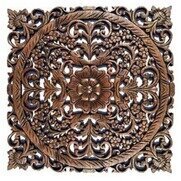
Popularly known as the ‘sheesham wood village’, Saharanpur is home to some of India's finest wood carvers. The city is internationally famous for this craft and its artisans who have been creating magic with the material for years. The intricate and fine workmanship is what makes these products unique.
Under the patronage of different monarchs, the city has developed a unique style of wood carving craft primarily done on sheesham wood borrowing elements from the Mughal art and architecture. The origin of Saharanpur woodcraft can be traced from the late nineteenth century which also finds place in the textual records of Saharanpur Sandarbh. The wood carving industry in Saharanpur has grown rapidly since Independence because of a full-fledged strategy to promote it. Public sector cooperatives provide institutional support to the industry in terms of production and marketing.
India abounds in trees which provide the raw material for woodcraft, in fact, Indian wood is quite famous worldwide. Teak wood, Sheesham, Deodar, Ebony, Redwood, Rosewood, Red cedar, Sal and many others are the wood from India which are extensively used by Indian craftsmen, as they lend themselves to fine decorative carving and inlay work.
It’s not just the quality of wood that is superior (most use sheesham wood), but the finely detailed handwork of the wood carvers that distinguishes Saharanpur’s woodcarvers from the others.
The design in Saharanpur woodwork features largely natural motifs, trees, flowers, creepers, and their signature style leaf. The vine-leaf patterns are a specialty of this region. Geometric and figurative carving is also done along with gorgeous brass inlay work. Other materials like wrought iron, ceramic and glass are being combined with wood to give a new dimension to the craft and ‘contemporize’ the traditional products.
The products vary from kitchen tools to temples and furniture to toys, these wooden handicrafts travel from tiny workshops to plush showrooms in the country and are exported throughout the world.
Wooden Handicraft is a trademark of the rich culture and heritage that the city claims to possess. The handicrafts carry the designs and complexity of its rich heritage. Wood carving undoubtedly possessed a prominent place amongst the greatest art forms ever since antiquity. Each piece reflects a part of the rich cultural heritage of India.
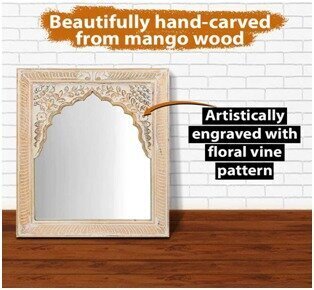
MAKING PROCESS:
Selection of raw material is the first stage of the workshop process which goes through different operations. Although the process of making woodcraft is tedious because it is a multistage process in which wood is used by one artisan, then another and so on: for different operations. A wide range of wood types is used to make products. Sheesham for small items, Teak wood for furniture and Mango for antique items. After the purchase of wood from the mandi, wood must go through seasoning and chemical treatment processes, thereafter it is sent to the manufacturing unit where different operations are done by different artisans. Sale is the last operation of any goods.
All of them go through the same basic steps - Slicing, Carving, Inlaying, Sanding, Polishing and Assembling. Craftsmen specialize in one (or more) of these processes and perform just that every day. So each product is actually handcrafted by not one karigar but many.
- Slicing- The first step is to cut the logs of wood into flat slabs. This is called ‘lakdicheerna’ and is done using an electric saw. Usually, two men hold the wood firmly to cut it precisely. These pieces are marked with pencil and cut in different shapes and sizes according to the desired product, then are worked upon by the carving artisans.

- Carving- Carving is done either completely by hand or in combination with an electric saw. The saw is usually employed to make geometric patterns in wooden boxes. The whole operation is started by drawing the pattern intended to be carved on a piece of paper and pasting it over the surface. Holes are drilled to precisely (and quickly) carve out the negative spaces. Carving completely by hand makes for a very fascinating sight. Though the instruments used are extremely simple (saw, plane, fine-grained hard stone, chisels etc.), the carvers use them aptly to produce some astonishing results with minute details, keeping the intricacies and subtle light and shade effects, every desired curve, expression, and texture.

- Inlaying- Brass is extensively used for inlaying floral, geometric and typographic patterns into wood. This is done by cutting strips of metal and then die-pressing them to get the desired shape. These pieces are then sold by weight to the carvers who make grooves for them beforehand. They beat these into the wood, stick them with wood adhesive and finally nailed them for durability. The waste strips are recycled into fresh metal and used again. Sometimes bone and plastic are also used for inlay work. Apart from embedding brass into wood, the karigars of Saharanpur have started combining wrought iron with wood. This is either to lend strength to the structure of the product (like chairs, tables, beds etc.) or pure aesthetic value (like in vases, lanterns, candle holders etc.).

- Polishing- Sanding and buffing are the dustiest processes out of all. The most astonishing bit is that the workers do not even use any mask or eyeglass. They work all day at the machine to make the piece smooth and shiny. After this the polishing experts come into the picture and rub loads of putty to even out the unfinished edges and cracks. When it dries, the wooden piece is smoothened further with sandpaper and then coated with paint or polish, depending on the desired finish. One of the most promising orders for the painters are the gold intricate furniture pieces that adorn a lot of big homes in the cities. They are big and bring in good business. Liquid, gold, ready-to-use paint is being used instead of powder because that does not blacken with time. And it looks prettier. Polish finishes include the regular natural, walnut and rosewood. Maintenance for such pieces is easy: brush it off dry.

- Assembling- Adding rivets, metal hinges or any other interesting element is about giving the product its final touch and assembling several components is just the last task before it goes into its packaging box. Ready to sell!
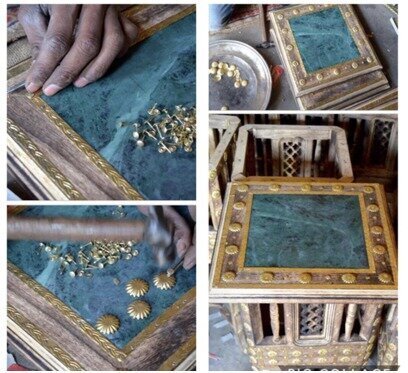
Products:
In the present scenario, not only in India but products from Saharanpur are appreciated in the international market, especially in Europe, the USA, and the Middle East. Traces of Saharanpur wooden work can be found everywhere – right from Rajasthan’s beautiful heritage doors to Bahrain’s king’s furniture, and to wooden toys manufactured by brands, and furniture showrooms across the world.
The ‘typical’ product range includes decorated furniture (sofa sets, chairs, tables, stools, wall brackets, closets etc.), candle holders, screens, room-dividers, tableware (bowls, trays, cooking spatula etc.), boxes, mirror frames, bookshelves, pen stands, religious products and children’s toys.
Apart from these, the craftsmen are trying out newer products and materials every day to innovate upon the existing product categories.
Religious Products-

Home decor & Furniture-

Kitchen Utilities-
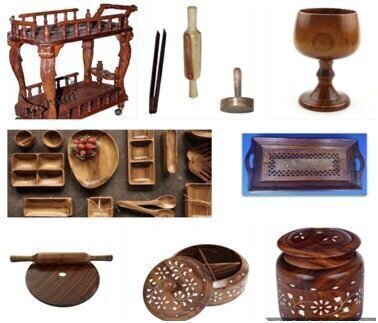
Toys-
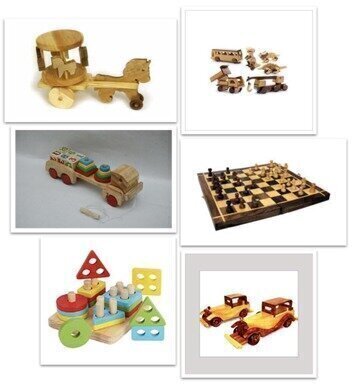
Saharanpur’s woodcraft industry is a flourishing one. Unlike other art forms in the country, it is not anticipating an unfortunate death. The demand has been constant, so has their hard work and innovation, despite many challenges. In small workshops of Saharanpur, woodcarvers fret, fit and polish their carvings for a revitalized urban market in India and abroad. Their own future, however, is precarious. Spiraling prices of fast-depleting raw materials and a market controlled by middlemen threaten to choke this once thriving trade. Apart from that, the 10-hour work shift, 6-days-a-week, on the floor job requires them to be bent over at most times, putting a lot of strain on the necks and backs. Working without safety equipment like masks or shades means that the sawdust often ends up in their eyes or their lungs, which cause irritation and infections. They usually eat jaggery to keep their throats clear but would still end up with problems like poor eyesight.
Despite facing the challenges, the craftsmen put their soul in the work and take pride in showing their carving magic through a variety of products. They ‘breathe life into dead trees’ is how they like to put it. Saharanpur Handicrafts can never go out of style as these units are meant to last for ages to come.
 1,12,000 Artisans families benefited so far
1,12,000 Artisans families benefited so far
